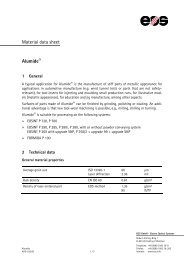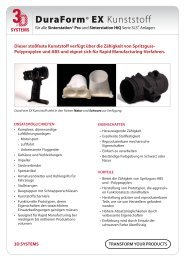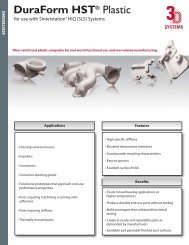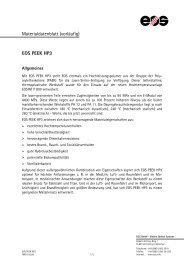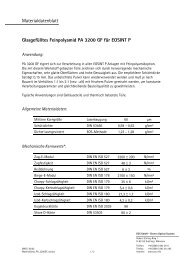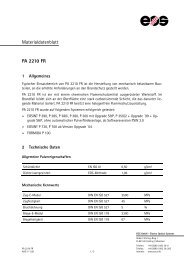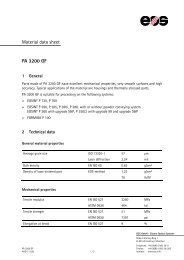Material data sheet Directmetal and Directsteel materials for ...
Material data sheet Directmetal and Directsteel materials for ...
Material data sheet Directmetal and Directsteel materials for ...
You also want an ePaper? Increase the reach of your titles
YUMPU automatically turns print PDFs into web optimized ePapers that Google loves.
<strong>Material</strong> <strong>data</strong> <strong>sheet</strong><br />
DirectMetal <strong>and</strong> DirectSteel <strong>materials</strong> <strong>for</strong> EOSINT M 250 Xtended<br />
A number of different <strong>materials</strong> are available <strong>for</strong> use with EOSINT M 250 Xtended systems, offering<br />
a broad range of e-Manufacturing applications. All of the <strong>materials</strong> were developed <strong>and</strong><br />
optimised especially <strong>for</strong> Direct Metal Laser-Sintering (DMLS) on EOSINT M systems <strong>and</strong> are suitable<br />
<strong>for</strong> manufacturing moulds <strong>and</strong> tool inserts using the DirectTool process as well as<br />
functional prototypes using the DirectPart process.<br />
This document provides brief descriptions of the most commonly used <strong>materials</strong> <strong>and</strong> their principle<br />
applications, <strong>and</strong> a table of technical <strong>data</strong>. For the machine requirements of the various<br />
<strong>materials</strong> please see the in<strong>for</strong>mation quotes. Coarser versions of some <strong>materials</strong> are also available,<br />
details can be provided on request. Please note that additional <strong>materials</strong> are available <strong>for</strong><br />
Direct Metal Laser-Sintering on EOSINT M 270 systems - please refer to the relevant material<br />
<strong>data</strong> <strong>sheet</strong>s <strong>for</strong> details.<br />
Laser-sintered parts made from these <strong>materials</strong> can be welded, machined, micro shot-peened,<br />
polished <strong>and</strong> coated if required. Unexposed powder can be reused without restriction or refreshing.<br />
Description, application<br />
DirectMetal 20<br />
DirectMetal 20 is a very fine-grained bronze-based, multi-component metal powder. The resulting<br />
parts offer good mechanical properties combined with excellent detail resolution <strong>and</strong><br />
surface quality. The surfaces can be easily post-processed by shot-peening <strong>and</strong> can be polished<br />
with very little ef<strong>for</strong>t. The specially developed powder mixture contains different components<br />
which exp<strong>and</strong> during the laser-sintering process, partially compensating <strong>for</strong> the natural solidification<br />
shrinkage <strong>and</strong> thereby enabling a very high part accuracy to be achieved.<br />
This material is ideal <strong>for</strong> most prototype injection moulding tooling applications (DirectTool) <strong>and</strong><br />
<strong>for</strong> many functional metal prototype applications (DirectPart). It offers the highest building<br />
speed so is particularly suitable <strong>for</strong> larger tools <strong>and</strong> parts. It also offers a broad window of usable<br />
process parameters, e.g. a wide range of achievable mechanical properties <strong>and</strong> build speeds.<br />
St<strong>and</strong>ard parameters use 20 µm layer thickness <strong>for</strong> the skin <strong>and</strong> 60 µm layers <strong>for</strong> the core, but<br />
<strong>for</strong> faster building the entire part can be built using 40 µm layers <strong>for</strong> the skin <strong>and</strong> 80 µm layers<br />
or the core, or even 60 µm layer thickness <strong>for</strong> skin <strong>and</strong> core.<br />
EOS GmbH - Electro Optical Systems<br />
Robert-Stirling-Ring 1<br />
D-82152 Krailling / München<br />
Telephone: +49 (0)89 / 893 36-0<br />
MS / 01.06 Telefax: +49 (0)89 / 893 36-285<br />
DM_DS_M250X_<strong>Material</strong>_<strong>data</strong>_<strong>sheet</strong>_01-06_en.doc 1 / 7 Internet: www.eos.info
<strong>Material</strong> <strong>data</strong> <strong>sheet</strong><br />
Using st<strong>and</strong>ard skin parameters the mechanical properties are fairly uni<strong>for</strong>m in all directions,<br />
which is especially beneficial <strong>for</strong> many DirectPart applications. Areas built with core parameters<br />
have a porous structure, but the combination of skin <strong>and</strong> core produces in a strong total part.<br />
Parts built from DirectMetal 20 also have good corrosion resistance.<br />
Typical applications:<br />
- injection moulds <strong>and</strong> inserts <strong>for</strong> moulding up to tens or even hundreds of thous<strong>and</strong>s of<br />
parts in st<strong>and</strong>ard thermoplastics using st<strong>and</strong>ard injection parameters<br />
- direct manufacture of functional metal prototypes.<br />
DirectSteel 20<br />
DirectSteel 20 is a very fine-grained steel-based, multi-component metal powder. The resulting<br />
parts offer fine detail resolution <strong>and</strong> high accuracy with very good mechanical properties. They<br />
have a high density <strong>and</strong> strength, <strong>and</strong> can be post-processed by shot-peening, polishing etc. to<br />
achieve a high surface quality. The specially developed powder mixture contains different components<br />
which exp<strong>and</strong> during the laser-sintering process, partially compensating <strong>for</strong> the natural<br />
solidification shrinkage <strong>and</strong> thereby enabling a very high part accuracy to be achieved.<br />
This material is suitable <strong>for</strong> heavier duty applications such as injection moulding of larger quantities<br />
of parts or <strong>sheet</strong> metal stamping (DirectTool), as well as <strong>for</strong> functional metal prototypes<br />
(DirectPart). St<strong>and</strong>ard parameters use 20 µm layer thickness <strong>for</strong> the outer skin <strong>and</strong> 60 µm layers<br />
<strong>for</strong> the core, but <strong>for</strong> faster building the entire part can be built using 40 µm layers <strong>for</strong> the skin<br />
<strong>and</strong> 80 µm layers <strong>for</strong> the core or even 60 µm layers <strong>for</strong> the skin <strong>and</strong> core. Using st<strong>and</strong>ard parameters<br />
the mechanical properties in the vertical (build) direction may be significantly lower<br />
than in the horizontal (layer) direction, which should be considered especially <strong>for</strong> DirectPart applications.<br />
Typical applications:<br />
- heavy duty injection moulds <strong>and</strong> inserts <strong>for</strong> moulding all st<strong>and</strong>ard thermoplastics using<br />
st<strong>and</strong>ard injection parameters, with achievable tool life of up to hundreds of thous<strong>and</strong>s of<br />
parts<br />
- direct manufacturing of functional metal prototypes.<br />
EOS GmbH - Electro Optical Systems<br />
MS / 01.06 Robert-Stirling-Ring 1<br />
DM_DS_M250X_<strong>Material</strong>_<strong>data</strong>_<strong>sheet</strong>_01-06_en.doc 2 / 7 D-82152 Krailling / München
<strong>Material</strong> <strong>data</strong> <strong>sheet</strong><br />
DirectSteel H20<br />
DirectSteel H20 is a very fine grained steel-based, multi-component metal powder which offers<br />
offers high strength, hardness, wear resistance <strong>and</strong> surface density. The resulting parts have<br />
properties similar to conventional tool steels <strong>and</strong> can be polished to an excellent, pore-free<br />
surface finish. This material is particularly suitable <strong>for</strong> DirectTool applications such as injection<br />
moulds <strong>for</strong> series production, pressure die-casting tooling <strong>and</strong> other applications where high<br />
strength <strong>and</strong> wear resistance <strong>and</strong>/or best possible surface quality are important. It is also suitable<br />
<strong>for</strong> heavy duty DirectPart applications. St<strong>and</strong>ard parameters use 20 µm layer thickness <strong>for</strong><br />
the outer skin <strong>and</strong> 60 µm layers <strong>for</strong> the core, but <strong>for</strong> faster building thicker layers can be used as<br />
<strong>for</strong> DirectSteel 20. To achieve the high density <strong>and</strong> hardness, the skin area is completely melted,<br />
which results in slower build speed than <strong>for</strong> DirectSteel 20. This should be considered especially<br />
<strong>for</strong> large tools <strong>and</strong> parts. Mechanical properties are generally higher in the building plane (XY)<br />
than perpendicular to the building plane (Z).<br />
Typical applications:<br />
- heavy duty injection moulds <strong>and</strong> inserts <strong>for</strong> moulding all st<strong>and</strong>ard thermoplastics using<br />
st<strong>and</strong>ard injection parameters, with achievable tool life of up to millions of parts<br />
- die casting moulds <strong>for</strong> small series of up to several thous<strong>and</strong> parts in light alloys<br />
- metal stamping <strong>and</strong> other heavy duty tooling applications<br />
- direct manufacturing of heavily loaded functional metal prototypes.<br />
EOS GmbH - Electro Optical Systems<br />
MS / 01.06 Robert-Stirling-Ring 1<br />
DM_DS_M250X_<strong>Material</strong>_<strong>data</strong>_<strong>sheet</strong>_01-06_en.doc 3 / 7 D-82152 Krailling / München
<strong>Material</strong> <strong>data</strong> <strong>sheet</strong><br />
Technical <strong>data</strong><br />
General process <strong>data</strong><br />
Minimum recommended layer<br />
thickness<br />
Typical achievable part<br />
accuracy [1]<br />
Accuracy specification <strong>for</strong> qualification<br />
[2]<br />
DirectMetal 20 DirectSteel 20 DirectSteel H20<br />
20 µm<br />
0.8 mil<br />
± 50 µm<br />
2.0 mil<br />
± (0.07 % + 50 µm)<br />
± (0.07 % + 2.0 mil)<br />
Min. wall thickness [3] 0.6 mm<br />
0.024 in<br />
Volume rate [4]<br />
- st<strong>and</strong>ard core parameters 15 mm³/s<br />
3.3 in³/h<br />
- st<strong>and</strong>ard skin parameters 2 - 8 mm³/s<br />
0.4 – 1.8 in³/h<br />
- 40 µm layer core parameters 16 mm³/s<br />
3.5 in³/h<br />
- 40 µm layer skin parameters 4 – 10 mm³/s<br />
0.9 – 2.2 in³/h<br />
- 60 µm layer core parameters 18 mm³/s<br />
4.0 in³/h<br />
- 60 µm layer skin parameters 6 - 12 mm³/s<br />
1.3 – 2.6 in³/h<br />
20 µm<br />
0.8 mil<br />
± 50 µm<br />
2.0 mil<br />
± (0.07 % + 50 µm)<br />
± (0.07 % + 2.0 mil)<br />
0.7 mm<br />
0.028 in<br />
7.5 mm³/s<br />
1.6 in³/h<br />
1.5 – 2.5 mm³/s<br />
0.3 – 0.5 in³/h<br />
8 mm³/s<br />
1.8 in³/h<br />
2 – 4 mm³/s<br />
0.4 – 0.9 in³/h<br />
10 mm³/s<br />
2.2 in³/h<br />
2.5 – 5 mm³/s<br />
0.5 – 1.1 in³/h<br />
[1] Based on users' experience of dimensional accuracy <strong>for</strong> typical geometries<br />
[2] Valid <strong>for</strong> EOS st<strong>and</strong>ard qualification part <strong>and</strong> procedure<br />
[3] Mechanical stability is dependent on geometry (wall height etc.) <strong>and</strong> application<br />
20 µm<br />
0.8 mil<br />
± 50 µm<br />
2.0 mil<br />
± (0.07 % + 50 µm)<br />
± (0.07 % + 2.0 mil)<br />
0.7 mm<br />
0.028 in<br />
4 mm³/s<br />
0.9 in³/h<br />
0.5 - 3 mm³/s<br />
0.1 – 0.7 in³/h<br />
5 mm³/s<br />
1.1 in³/h<br />
1 - 3 mm³/s<br />
0.2 – 0.7 in³/h<br />
[4] Volume rate is a measure of build speed during laser exposure. DirectMetal <strong>and</strong> DirectSteel parts are typically<br />
build using Skin & Core strategy, in some cases using inner <strong>and</strong> outer skins. The average volume rate <strong>for</strong> a<br />
particular part is there<strong>for</strong>e geometry-dependent. The total build speed depends on the average volume rate,<br />
the recoating time (related to number of layers) <strong>and</strong> other factors such as DMLS-Start settings.<br />
EOS GmbH - Electro Optical Systems<br />
MS / 01.06 Robert-Stirling-Ring 1<br />
DM_DS_M250X_<strong>Material</strong>_<strong>data</strong>_<strong>sheet</strong>_01-06_en.doc 4 / 7 D-82152 Krailling / München<br />
-<br />
-
<strong>Material</strong> <strong>data</strong> <strong>sheet</strong><br />
Physical <strong>and</strong> chemical properties of laser-sintered parts<br />
<strong>Material</strong> composition after lasersintering<br />
DirectMetal 20 DirectSteel 20 DirectSteel H20<br />
bronze-based matrix<br />
containing Ni<br />
Density in skin areas 7.6 g/cm³<br />
0.27 lb/in³<br />
Density in core areas 6.3 g/cm³<br />
0.23 lb/in³<br />
steel-based matrix<br />
containing Ni<br />
7.6 g/cm³<br />
0.27 lb/in³<br />
6.3 g/cm³<br />
0.23 lb/in³<br />
alloy steel containing<br />
Cr, Ni, Mo, Si, V, C<br />
7.8 g/cm³<br />
0.28 lb/in³<br />
7.0 g/cm³<br />
0.25 lb/in³<br />
Remaining porosity (min.) 8 % 2 % < 0.5 %<br />
Mechanical properties of laser-sintered parts<br />
Tensile strength (MPIF 10) [5]<br />
- as laser-sintered (max.) 400 MPa<br />
58 ksi<br />
DirectMetal 20 DirectSteel 20 DirectSteel H20<br />
580 MPa<br />
84 ksi<br />
1100 MPa<br />
159 ksi<br />
- after heat treatment [6] 5 – 10 % higher<br />
Yield strength [5]<br />
- as laser-sintered (max.) 200 MPa<br />
29 ksi<br />
400 MPa<br />
58 ksi<br />
800 MPa<br />
116 ksi<br />
- after heat treatment [6] 10 – 15 % higher<br />
Transverse rupture strength<br />
(MPIF 41) [5]<br />
700 MPa<br />
101 ksi<br />
1000 MPa<br />
145 ksi<br />
2000 MPa<br />
290 ksi<br />
Elongation at break (max.) 2.5 % 1.5 % 4.0 %<br />
Young’s modulus 80 GPa<br />
11.6 msi<br />
130 GPa<br />
18.8 msi<br />
180 GPa<br />
26.1 msi<br />
EOS GmbH - Electro Optical Systems<br />
MS / 01.06 Robert-Stirling-Ring 1<br />
DM_DS_M250X_<strong>Material</strong>_<strong>data</strong>_<strong>sheet</strong>_01-06_en.doc 5 / 7 D-82152 Krailling / München
<strong>Material</strong> <strong>data</strong> <strong>sheet</strong><br />
Hardness [7]<br />
- as laser-sintered 110 HB, 115 HV<br />
(≅ 65 HRB)<br />
DirectMetal 20 DirectSteel 20 DirectSteel H20<br />
220 HB, 225 HV<br />
(≅ 94 HRB)<br />
350 - 420 HV,<br />
35 - 42 HRC<br />
- after micro shot-peening 380 - 420 HV,<br />
38 - 42 HRC<br />
- after nitriding [8] 380 HB, 400 HV<br />
(≅ 112 HRB)<br />
500 - 700 HV<br />
- after hard coating [9] > 2000 HV > 2000 HV > 2000 HV<br />
Surface roughness<br />
- as laser-sintered Ra 9, Rz 40 - 50 µm<br />
Ra 0.35, Rz 1.6 - 2.0 mil<br />
- after shot-peening Ra 3, Rz 15 µm<br />
Ra 0.12, Rz 0.6 mil<br />
- after polishing Rz up to < 1 µm,<br />
< 0.04 mil<br />
Ra 10, Rz 50 µm<br />
Ra 0.39, Rz 2.0 mil<br />
Ra 4, Rz 15 µm<br />
Ra 0.16, Rz 0.6 mil<br />
Rz up to < 1 µm,<br />
< 0.04 mil<br />
Ra 10, Rz 40 - 50 µm<br />
Ra 0.39, Rz 1.6 - 2.0 mil<br />
Ra 5, Rz 25 µm<br />
Ra 0.2, Rz 1.0 mil<br />
Rz up to < 1 µm,<br />
< 0.04 mil<br />
[5] Mechanical properties including strength can vary according to orientation, depending on the material <strong>and</strong><br />
parameters used. The quoted values are measured parallel to the building plane (X or Y direction), which typically<br />
gives the best properties.<br />
[6] Heated to 900 – 1000 °C (1600 – 1800 °F) then quenched in water<br />
[7] Brinell hardness measurement (HB) according to DIN EN ISO 6506-1, abbreviated to HBW 2,5 / 62,5. Vickers<br />
hardness measurement (HV) according to DIN EN ISO 6507-1. Rockwell B (HRB) <strong>and</strong> Rockwell C (HRC) hardness<br />
measurement according to DIN EN ISO 6508-1. Values in parentheses are converted in accordance with<br />
DIN 50150, which is applicable to cast steels <strong>and</strong> there<strong>for</strong>e only gives an indication <strong>for</strong> laser-sintered <strong>materials</strong>.<br />
Note that depending on the measurement method used, the measured hardness value can be dependent<br />
on the surface roughness <strong>and</strong> can be lower than the real hardness. To avoid inaccurate results, hardness<br />
should be measured on a polished surface.<br />
[8] Results <strong>for</strong> DirectSteel 20 from short-term plasma nitriding, <strong>for</strong> DirectSteel H20 from Nitroc process (conventional<br />
nitriding)<br />
[9] Surface hardness of TiN or CrN coating applied by PVD<br />
EOS GmbH - Electro Optical Systems<br />
MS / 01.06 Robert-Stirling-Ring 1<br />
DM_DS_M250X_<strong>Material</strong>_<strong>data</strong>_<strong>sheet</strong>_01-06_en.doc 6 / 7 D-82152 Krailling / München
<strong>Material</strong> <strong>data</strong> <strong>sheet</strong><br />
Thermal properties of laser sintered parts<br />
Coefficient of thermal expansion 18 x 10 -6 m/m°C<br />
32 x 10 -6 in/in°F<br />
Thermal conductivity 30 W/mK [11]<br />
208 Btu/(h .ft² °F/in)<br />
Maximum operating temperature 400 °C<br />
750 °F<br />
DirectMetal 20 DirectSteel 20 DirectSteel H20<br />
9 x 10 -6 m/m°C<br />
16 x 10 -6 in/in°F<br />
13 W/mK<br />
90 Btu/(h ft² °F/in)<br />
600 °C<br />
1110 °F<br />
[10] Lowest value is <strong>for</strong> 100 - 250 °C (212 - 482 °F), highest value is <strong>for</strong> 400 - 550 °C (752 - 1022 °F)<br />
[11] At 50 °C (122 °F)<br />
[12] Lowest value is <strong>for</strong> 50 °C (122 °F), highest value is <strong>for</strong> 200 °C (392 °F)<br />
13-15 x 10 -6 m/m°C [10]<br />
23-27 x 10 -6 in/in°F [10]<br />
15 – 18 W/mK [12]<br />
104-125 Btu/(h ft² °F/in)<br />
800 °C<br />
1470 °F<br />
The quoted values refer to the use of these <strong>materials</strong> with EOSINT M 250 Xtended systems according to current<br />
specifications (including the latest released process software PSW <strong>and</strong> any hardware specified <strong>for</strong> the relevant material)<br />
<strong>and</strong> operating instructions. All values are approximate. Unless otherwise stated, the quoted mechanical <strong>and</strong><br />
physical properties refer to st<strong>and</strong>ard building parameters, (outer) skin areas <strong>and</strong> test samples built in horizontal orientation.<br />
They depend on the building parameters <strong>and</strong> strategies used, which can be varied by the user according<br />
to the application.<br />
The <strong>data</strong> are based on our latest knowledge <strong>and</strong> are subject to changes without notice. They are provided as an indication<br />
<strong>and</strong> not as a guarantee of suitability <strong>for</strong> any specific application.<br />
EOS ® , EOSINT ® , DMLS ® , DirectMetal ® , DirectSteel ® , DirectTool ® <strong>and</strong> DirectPart ® are registered trademarks of<br />
EOS GmbH.<br />
© 2006 EOS GmbH – Electro Optical Systems. All rights reserved.<br />
EOS GmbH - Electro Optical Systems<br />
MS / 01.06 Robert-Stirling-Ring 1<br />
DM_DS_M250X_<strong>Material</strong>_<strong>data</strong>_<strong>sheet</strong>_01-06_en.doc 7 / 7 D-82152 Krailling / München



